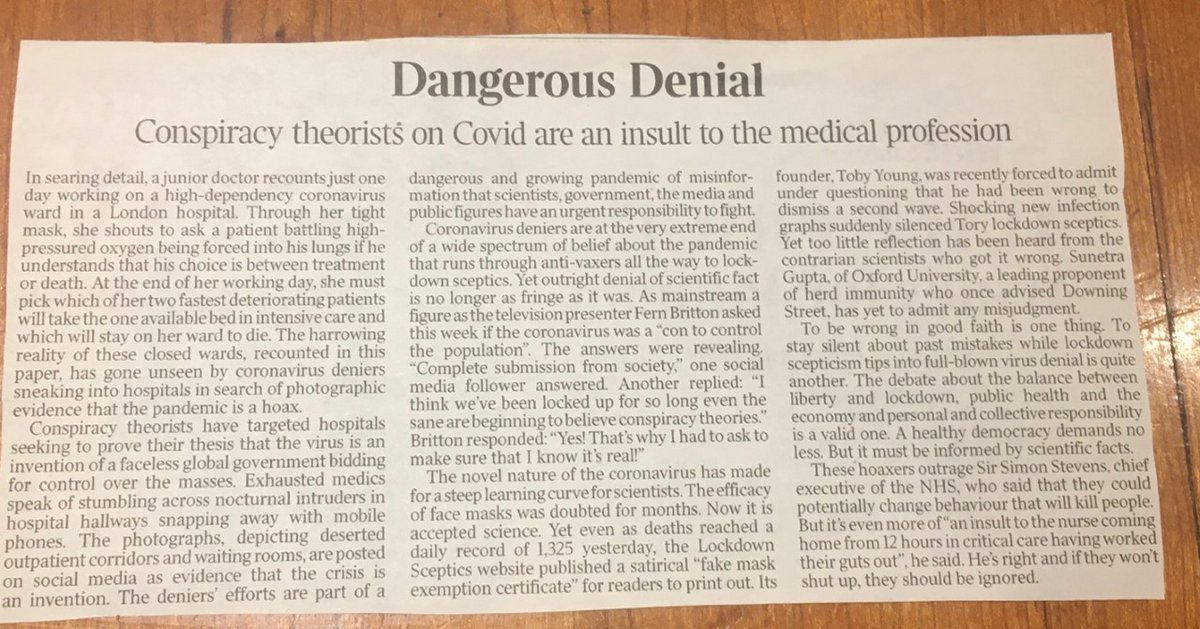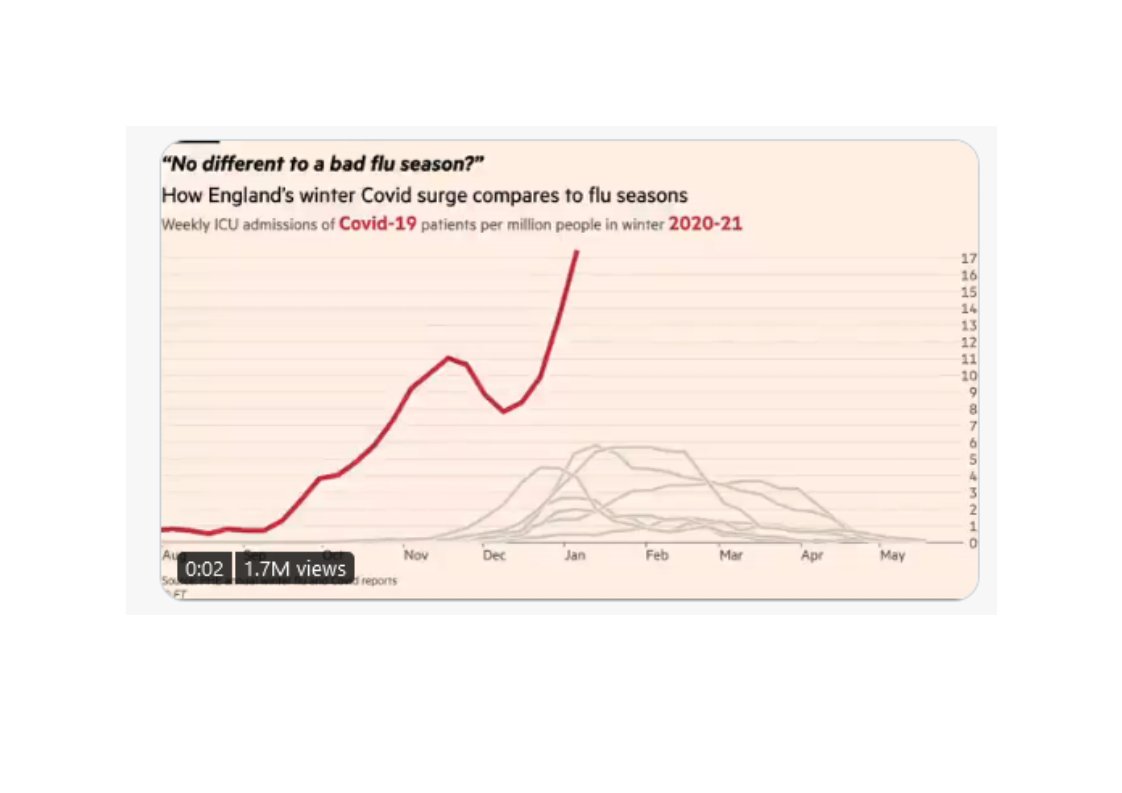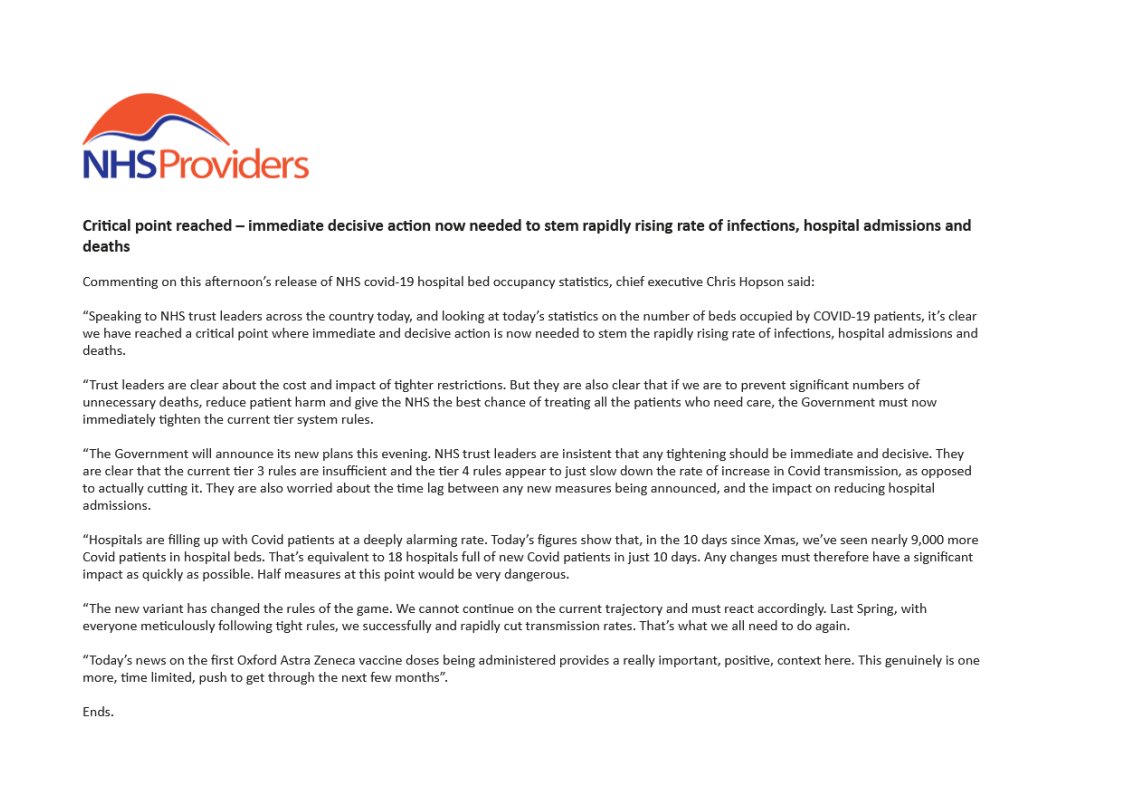
1/22 It is deeply worrying that some are already arguing for plans to rapidly relax restrictions on social contact when the NHS is still under such intense pressure. My new comment piece for @ObserverUK on the many reasons to be cautious: theguardian.com/commentisfree/…. Thread below.
2/22 Until we can vaccinate population, restrictions on social contact are only way to prevent unnecessary deaths, reduce patient harm & give NHS the best chance to treat all patients it needs to. Trust leaders are therefore very worried about relaxing restrictions too quickly.
3/22 These must be decisions for elected politicians as only they can balance the complex and difficult trade offs required, using the evidence and advice they receive. But NHS trust leaders believe that there are seven reasons to be very cautious at this point.
4/22 First, new variant behaving in very different ways from the virus in first phase. We know it’s significantly more transmissible. But there’s a lot we don’t know. EG good reasons to believe that the drop in case numbers will be significantly slower than in the first phase...
5/22 ...One of the distinguishing features last summer was how quickly case numbers dropped once the peak had been crested. If we relax the current restrictions on the basis that case numbers will decline on a similarly rapid basis this time, we risk loosening far too quickly.
6/22 Second, trust leaders point to the importance of infection rates dropping to a very low level before relaxing restrictions, as illustrated by the second phase in Sept-Nov. Trusts in the north found that virus prevalence never really went away over the summer....
7/22 ..So as soon as restrictions were lifted, case rates, hospitalisations & deaths rose rapidly. NHS leaders want to see case numbers drop consistently to much lower levels, for a longer period of time, before we start lifting restrictions this time. This will be some time away
8/22 Third, this links to importance of NHS having sufficient capacity. NHS success in developing covid-19 treatments means the mortality rate has dropped. But the corollary is larger numbers of seriously ill recovering patients needing longer hospital stays than in first phase..
9/22 ...NHS needs to return to more manageable levels of demand before relaxing rules. Best predictions are another 4-6 weeks of current levels of intense pressure. NHS will then need time to stabilise to be confident of dealing with any new surge triggered by rule relaxation.
10/22 Current vaccination campaign will, over time, reduce pressure on hospitals as more people inoculated against worst effects of disease. But precise interaction between increasing vaccination rates, reducing rates of hospitalisation and relaxing restrictions remains opaque...
11/22 ...Because there’s still a huge amount that we don’t know. And it's this uncertainty that provides another set of important reasons of why we need to be very cautious about lifting restrictions.
12/22 So, fourth, we still can’t guarantee what the supply of vaccines will be and how quickly we will therefore be able to vaccinate the population. NHS doing incredibly well with current vaccination campaign but lumpiness in vaccine supply is a major constraint.
13/22 Fifth, we still don’t fully understand the impact of vaccination on transmission and need more data before deciding how quickly we can loosen restrictions without triggering infection and resulting death and harm in those who haven’t been vaccinated. This will take time.
14/22 Sixth, covid mortality and harm rates are highest amongst the four priority groups who are due to be vaccinated by mid February, including care home residents and carers, frontline health and care workers, the clinically vulnerable and people over 70...
15/22 ...But those calling for relaxation of rules based on mid Feb vaccination rates should remember impact of covid-19 on those who will have to wait longer for protection. They can still die, contract long covid and suffer long term harm....
16/22 ...There is currently some loose talk of trading relaxation of the rules for "acceptable, flu level like, death rates". Principle of NHS is to avoid unnecessary death and do all possible to prevent avoidable harm. So real concern over concepts like "acceptable death rates".
17/22 Seven, There is a strong read across here to pressures on the NHS. The Government has rightly said it will take full account of the pressure on the NHS in its decision making. But the pressure in hospitals is two fold – on both general and intensive care beds...
18/22 ...Whilst hospitalisations are very strongly skewed to the over 70 age group, that is not the case for ICU admissions. The current mean age for ICU patients since September is a disturbing 60 years old. icnarc.org/Our-Audit/Audi…. (22 Jan 2021 report page 26)....
19/22 ...So, vaccination campaign will help with pressure on general hospital beds. [We're still not exactly sure when (another reason to be cautious)]. But this will happen much more quickly than it will with pressures in critical care units. We need ICU capacity stabilised too.
20/22 In summary. NHS trust leaders are as keen as everyone else to return to normal. They can see the adverse impacts of the current restrictions on mental health and the wider economy and the worrying likely long term health impacts that will flow from these....
21/22 ...But the shocking number of covid deaths and widespread patient harm of the last few weeks makes them deeply concerned about loosening restrictions too rapidly. There is already a growing chorus of voices pushing for a precipitate loosening of restrictions....
22/22 ...That will only grow over the next few weeks. Those voices need to be resisted. We should only loosen restrictions on social contact when we have the evidence and data to confirm that we can do so without triggering a further full blown wave of infections.
• • •
Missing some Tweet in this thread? You can try to
force a refresh






